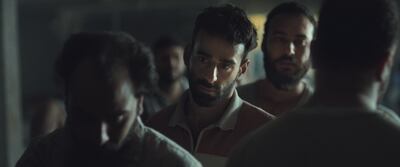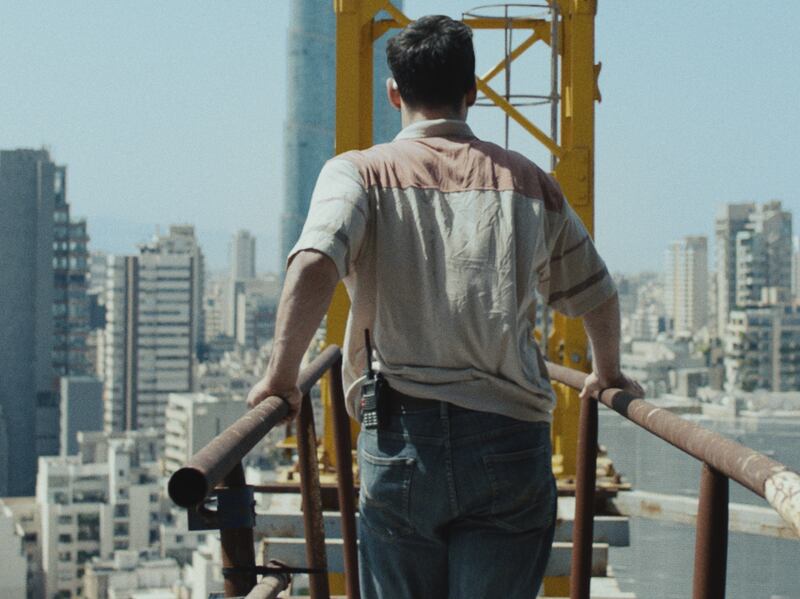Five years ago, Lebanese filmmaker Dania Bdeir was sitting on a balcony in Beirut when she noticed a construction crane in the distance and the silhouette of a man outside the cabin. “It was very far away, it looked very scary, I thought that he was about to jump,” she says. “And then he got down on his knees, and he put his forehead to the ground. And I realised that he was praying – and that image stuck in my head very, very much. It was such a beautiful sight.”
Immediately she became “infatuated” by crane operators. “It’s this person in a tiny cabin, operating this giant machinery, and they can see the world, but nobody can see them,” she says.
She envisioned creating a short film featuring such a character, though even Bdeir could not have imagined then that the result would feature cutting-edge movie technology and the taboo-busting Beirut singer and belly dancer Khansa.
The resulting 15-minute production, Warsha, is playing at Sundance Film Festival, as part of its online showcase until Sunday, January 30.
“Sundance – out of all festivals – has always been my dream. It’s so prestigious,” she says. “It’s extremely competitive for short films. There’s an acceptance rate of 0.7 per cent.”
Although the festival’s pandemic-related decision to go online means Bdeir can’t be there in person, she will get to screen the film physically at the Clermont-Ferrand International Short Film Festival in France, running from January 28 to February 5, before looking for a Mena premiere later in the year.
Certainly, Warsha is a film that deserves to be seen on the big screen – IMAX would be ideal – with its stomach-flipping vertiginous shots of the Beirut skyline. The story has a Syrian construction worker, Mohammad (Khansa), volunteer to ascend one of the Lebanese city's tallest cranes, a terrifying climb into the clouds. Here, though, he finds freedom of expression, as he discovers his inner diva, performing a remarkable dance routine in the most vertigo-inducing space you could imagine.
Bdeir first encountered Khansa when he released his first single, Khayef, in 2017, and she attended one of his concerts in Beirut. “The concert blew my mind. It was transcendental. It was way beyond a singer singing his songs. He was singing, he was dancing, he was using his body in interesting ways. He blended a lot of different art forms at the same time.”
After the concert, they began talking, with Bdeir revealing her idea for a short; they soon hit on the notion of the crane operator escaping the world below to express “a desire burning deep inside”.

Spending time with real-life Syrian construction workers, both during the research and shooting phase, Bdeir had a strong idea about what she wanted to film – but how to film it was another matter. Shockingly, in 2018, she shot a teaser – as a way of attracting financing – by climbing a crane herself.
“Right when we were about to go up the ladder, the camera operator froze. And he said, ‘I’m sorry, I can’t go up there. I have kids.’ And he just gave me the camera. And I had to take the camera and go up. I couldn’t help but get dizzy as soon as I grabbed onto the ladder because it’s just so high, so unsafe.”
Up in the cabin, Bdeir was able to glean tiny details for the film, such as the teapot that the operator had with them, but she also understood it would be impossible – and far too dangerous – to shoot any of the film from a real crane. Her producer Coralie Dias came up with an elegant solution after she’d met with French visual effects house La Planete Rouge, which was in the middle of building a new studio to house the most advanced 3D virtual tech around.

The usual method of filming such a scene would be shooting an actor in a studio against a green screen, then adding in background footage in post-production. A relatively new alternative, Unreal Engine is a method that allows for the sequence to be shot in an immersive 360-degree environment, with the backdrop playing in real-time around the performer on LED walls. “This is an incredible opportunity because it’s not usually reserved for short filmmakers,” says Bdeir. “It’s usually [seen] on Marvel films … it looked so real.”
Alongside Khansa’s dexterous performance, the incredibly beautiful footage – captured via drone cameras – of the Beirut skyline truly brings the piece alive. Bdeir says she and the team are even planning on releasing some limited edition NFTs out of the unused footage from the film.

Although her parents are Syrian, moving to Lebanon when she was young, Bdeir was raised in Beirut. “I don’t know if I necessarily would have been a filmmaker if I hadn’t grown up in Lebanon,” she says. Her “entrance” into film came after her father gave her a camera when she was aged 16. “I started filming everything around me.”
Almost a decade ago, she moved to New York, where she studied filmmaking at NYU, creating her 2016 thesis short In White, the story of a young woman returning from New York to Beirut for her father’s funeral. But after graduating, the idea of returning to Lebanon did not sit easily with her. “I couldn’t let myself live there.”
For the past 18 months, she’s been living in Dubai, and yet she still feels the emotional pull of her homeland. “I think like all Lebanese, even when we leave, our hearts stay there. There’s something that we can’t fully let go of.”
While currently developing ideas for episodic TV, Bdeir also has ambitions to make the step into feature filmmaking. And, who knows, maybe she’ll also make use of her new experience in visual effects. “Am I necessarily excited about making a sci-fi alien movie? I wouldn’t think so right away. But then again, I’m all about character development,” she says. “So if it’s emotional, and it stays with you, why not? I never say never.”





